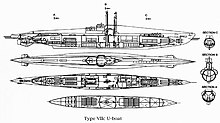
German submarine U-410

| History | |
|---|---|
| Name | U-410 |
| Ordered | 30 October 1939 |
| Builder | Danziger Werft, Danzig |
| Yard number | 111 |
| Laid down | 9 January 1941 |
| Launched | 14 October 1941 |
| Commissioned | 23 February 1942 |
| Fate | Sunk on 11 March 1944 by US aircraft[1] |
| General characteristics | |
| Class and type | Type VIIC submarine |
| Displacement | |
| Length |
|
| Beam |
|
| Height | 9.60 m (31 ft 6 in) |
| Draught | 4.74 m (15 ft 7 in) |
| Installed power |
|
| Propulsion |
|
| Speed |
|
| Range |
|
| Test depth |
|
| Complement | 4 officers, 40–56 enlisted |
| Armament |
|
| Service record[2] | |
| Part of: |
|
| Identification codes: | M 43 581 |
| Commanders: | |
| Operations: |
|
| Victories: | |
German submarine U-410 was a Type VIIC U-boat built for Nazi Germany's Kriegsmarine during World War II, operating mainly in the . Her insignia was a sword & shield,[3] she did not suffer any casualties until she was sunk.

U-410 was first commanded by Kapitänleutnant Kurt Sturm during her working up/training period and on her first patrol before being commanded by Horst-Arno Fenski for her six combat patrols. U-410 sank seven merchantmen, a Landing ship, Tank (LST); and a light cruiser during the Second World War. For his successes, Fenski received the Knight's Cross.

Design

German Type VIIC submarines were preceded by the shorter Type VIIB submarines. U-410 had a displacement of 769 tonnes (757 long tons) when at the surface and 871 tonnes (857 long tons) while submerged.[4] She had a total length of 67.10 m (220 ft 2 in), a pressure hull length of 50.50 m (165 ft 8 in), a beam of 6.20 m (20 ft 4 in), a height of 9.60 m (31 ft 6 in), and a draught of 4.74 m (15 ft 7 in). The submarine was powered by two Germaniawerft F46 four-stroke, six-cylinder supercharged diesel engines producing a total of 2,800 to 3,200 metric horsepower (2,060 to 2,350 kW; 2,760 to 3,160 shp) for use while surfaced, two Siemens-Schuckert GU 343/38–8 double-acting electric motors producing a total of 750 metric horsepower (550 kW; 740 shp) for use while submerged. She had two shafts and two 1.23 m (4 ft) propellers. The boat was capable of operating at depths of up to 230 metres (750 ft).[4]

The submarine had a maximum surface speed of 17.7 knots (32.8 km/h; 20.4 mph) and a maximum submerged speed of 7.6 knots (14.1 km/h; 8.7 mph).[4] When submerged, the boat could operate for 80 nautical miles (150 km; 92 mi) at 4 knots (7.4 km/h; 4.6 mph); when surfaced, she could travel 8,500 nautical miles (15,700 km; 9,800 mi) at 10 knots (19 km/h; 12 mph). U-410 was fitted with five 53.3 cm (21 in) torpedo tubes (four fitted at the bow and one at the stern), fourteen torpedoes, one 8.8 cm (3.46 in) SK C/35 naval gun, 220 rounds, a twin 2 cm (0.79 in), on Platform I, a 3.7 cm (1.5 in), on Platform II and two MG 15 machine guns on the bridge. The boat had a complement of between forty-four and sixty.[4]

She carried two eight-man, one six-man and 58 one-man, rubber boats.

Service history
U-410 was ordered by the Kriegsmarine on 30 October 1939. She was laid down at the Danziger Werft yard in Danzig, on 9 January 1941 and launched on 14 October 1941. She was formally commissioned into the Kriegsmarine, on 23 February 1942.

1st and 2nd patrols
U-410 departed Kiel on 27 August 1942 for her first patrol. The U-boat, under Kapitänleutnant Kurt Sturm, sank the British Newton Pine in mid-Atlantic. She then arrived in St. Nazaire in France on 28 October 1942, after 63 days at sea.

Her second outing was not so productive; after 33 days she returned to her French base empty-handed.

3rd and 4th patrols
Her third foray was more productive and included the sinking of the British ship Fort Battle River on 6 March 1943.[5] She also damaged another British vessel in the same engagement, Fort Paskoyac. Both of these ships were attacked southwest of Portugal. The U-boat returned to St. Nazaire on 27 March 1943.

Her fourth sortie included transiting the heavily defended Strait of Gibraltar. She arrived in La Spezia in Italy on 13 May 1943, having left St. Nazaire on 26 April.

5th and 6th patrols
U-410 left La Spezia on 7 August 1943 and attacked the convoy UGS-14 off the Algerian coast. Firing three torpedoes in a 'spread', she hit and sank two American ships, John Bell and Richard Henderson on 26 August 1943. She then sailed to Toulon in France, arriving on 30 August.

The U-boat tried to disrupt the landings at Anzio, sinking a British light cruiser and an American LST (see below).

Combat history
Commanders
- 23 February 1942 – 4 February 1943 Kapitänleutnant Kurt Sturm.
- 5 February 1943 – 11 March 1944 Oberleutnant zur See Horst-Arno Fenski
Flotillas
- 23 February – 31 August 1942 - 5th U-boat Flotilla
- 1 September 1942 – 31 May 1943 - 7th U-boat Flotilla
- 1 June 1943 – 11 March 1944 - 29th U-boat Flotilla
Wolfpacks
U-410 was part of the following "wolfpacks":

| Name | From | To | Notes |
|---|---|---|---|
| Lohs | 13 September 1942 | 22 September 1942 | |
| Blitz | 22 September 1942 | 26 September 1942 | |
| Tiger | 26 September 1942 | 29 September 1942 | |
| Letzte Ritter | 29 September 1942 | 1 October 1942 | |
| Wotan | 5 October 1942 | 17 October 1942 | |
| Raufbold | 11 December 1942 | 20 December 1942 | |
| Robbe | 16 February 1943 | 13 March 1943 |
Rescue of survivors from MV Rhakotis
On 2 January 1943, U-410 rescued 80 survivors from the German blockade-runner MV Rhakotis after she was sunk by HMS Scylla. The survivors were returned to St. Nazaire the next day.[6] Among the survivors were two Englishmen who received a special guard.

Sinking of HMS Penelope

On 18 February 1944, HMS Penelope (Capt. G.D. Belben, DSO, DSC, AM, RN), was leaving Naples to return to the Anzio area when she was torpedoed at 40°33′N 13°15′E / 40.55°N 13.25°E by U-410. A torpedo struck the British cruiser in the aft engine room; sixteen minutes later, U-410 fired another torpedo that hit Penelope in her boiler room, causing her immediate sinking. 415 of the crew, including the captain, went down with the ship. There were 206 survivors. The cruiser was making 26 knots (48 km/h; 30 mph) when she was hit, the fastest ship ever successfully attacked by a submarine.[7]

Sinking of USS LST-348
On 20 February 1944 LST-348 (Landing Ship, Tank) was returning from Sicily, supporting Operation Shingle and roughly 40 miles South of Naples when she was spotted by U-410, who fired two torpedoes at around 02:00 hrs. Both hit the vessel on her port side, she sank 20 minutes later.[8]

Loss
On 11 March 1944, U-410 along with U-380 were seriously damaged and subsequently declared non-operational.[1] Oberleutnant zur See Fenski and his crew transferred to U-371, which was lost around 04:00 on 4 May 1944 in a battle with Allied warships. Three of the crew were killed as they scuttled the boat, but Fenski survived and spent two years in a US POW camp.[9]

Summary of raiding history
| Date | Ship Name | Nationality | Tonnage[Note 1] | Fate[10] |
|---|---|---|---|---|
| 11 October 1942 | Newton Pine | 4,212 | Sunk | |
| 6 March 1943 | Fort Battle River | 7,133 | Sunk | |
| 6 March 1943 | Fort Paskoyac | 7,134 | Damaged | |
| 26 August 1943 | John Bell | 7,242 | Sunk | |
| 26 August 1943 | Richard Henderson | 7,194 | Sunk | |
| 26 September 1943 | Christian Michelsen | 7,176 | Sunk | |
| 1 October 1943 | Empire Commerce | 3,722 | Total loss | |
| 1 October 1943 | Fort Howe | 7,133 | Sunk | |
| 15 February 1944 | Fort St. Nicholas | 7,154 | Sunk | |
| 18 February 1944 | HMS Penelope | 5,270 | Sunk | |
| 20 February 1944 | USS LST-348 | 1,625 | Sunk |
References
Notes
- ^ Merchant ship tonnages are in gross register tons. Military vessels are listed by tons displacement.
Citations
- ^ a b Kemp 1999, p. 176.
- ^ Helgason, Guðmundur. "The Type VIIC boat U-410". German U-boats of WWII - uboat.net. Retrieved 5 November 2014.
- ^ U-Boat Insignia & Emblems http://www.uboataces.com/ref-insignia32.shtml#U-410
- ^ a b c d Gröner 1991, pp. 43–46.
- ^ "Fort Battle River Cargo Ship 1942-1943". Wrecksite. Retrieved 6 October 2023.
- ^ http://www.wrecksite.eu/wreck.aspx?58439%7C MV Rhakotis at wrecksite
- ^ Helgason, Guðmundur. "HMS Penelope (97) of the Royal Navy - British Light cruiser of the Arethusa class". German U-boats of WWII - uboat.net. Retrieved 30 December 2014.
- ^ "Tank Landing Ship LST". www.navsource.org.
- ^ "Horst-Arno Fenski". uboat.net. Retrieved 31 December 2019.
- ^ Helgason, Guðmundur. "Ships hit U-410". German U-boats of WWII - uboat.net. Retrieved 26 December 2014.
Bibliography
- Busch, Rainer; Röll, Hans-Joachim (1999). German U-boat commanders of World War II : a biographical dictionary. Translated by Brooks, Geoffrey. London, Annapolis, Md: Greenhill Books, Naval Institute Press. ISBN 1-55750-186-6.
- Busch, Rainer; Röll, Hans-Joachim (1999). Deutsche U-Boot-Verluste von September 1939 bis Mai 1945 [German U-boat losses from September 1939 to May 1945]. Der U-Boot-Krieg (in German). Vol. IV. Hamburg, Berlin, Bonn: Mittler. ISBN 3-8132-0514-2.
- Gröner, Erich; Jung, Dieter; Maass, Martin (1991). U-boats and Mine Warfare Vessels. German Warships 1815–1945. Vol. 2. Translated by Thomas, Keith; Magowan, Rachel. London: Conway Maritime Press. ISBN 0-85177-593-4.
- Kemp, Paul (1999). U-Boats Destroyed - German Submarine Losses in the World Wars. London: Arms & Armour. ISBN 1-85409-515-3.
External links
- Helgason, Guðmundur. "The Type VIIC boat U-410". German U-boats of WWII - uboat.net. Retrieved 26 December 2014.
- Photos of U-410 and her crew
- BBC A peoples War - John Alexander MN
See what we do next...
OR
By submitting your email or phone number, you're giving mschf permission to send you email and/or recurring marketing texts. Data rates may apply. Text stop to cancel, help for help.
Success: You're subscribed now !
